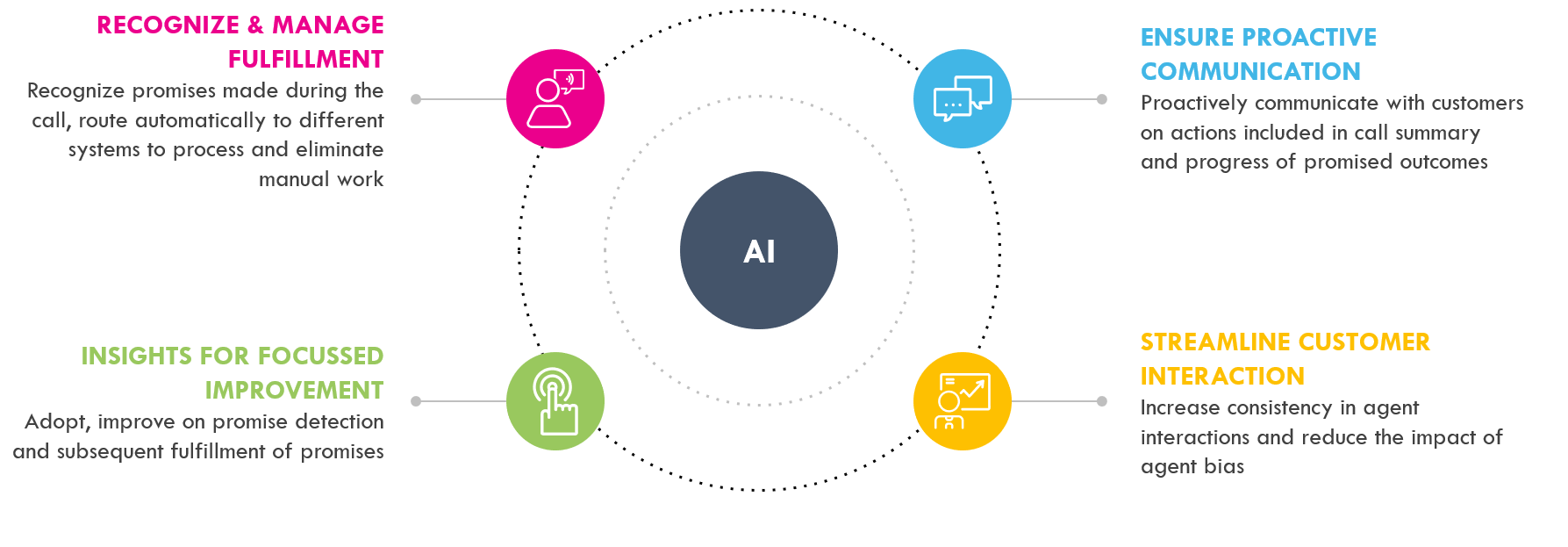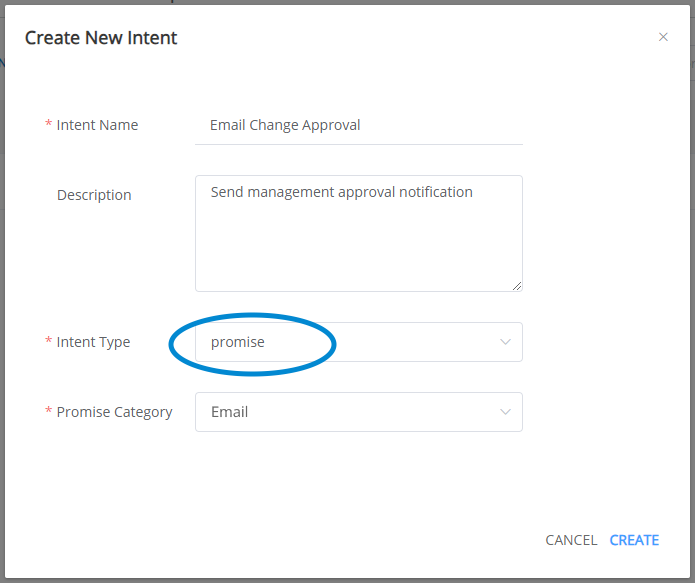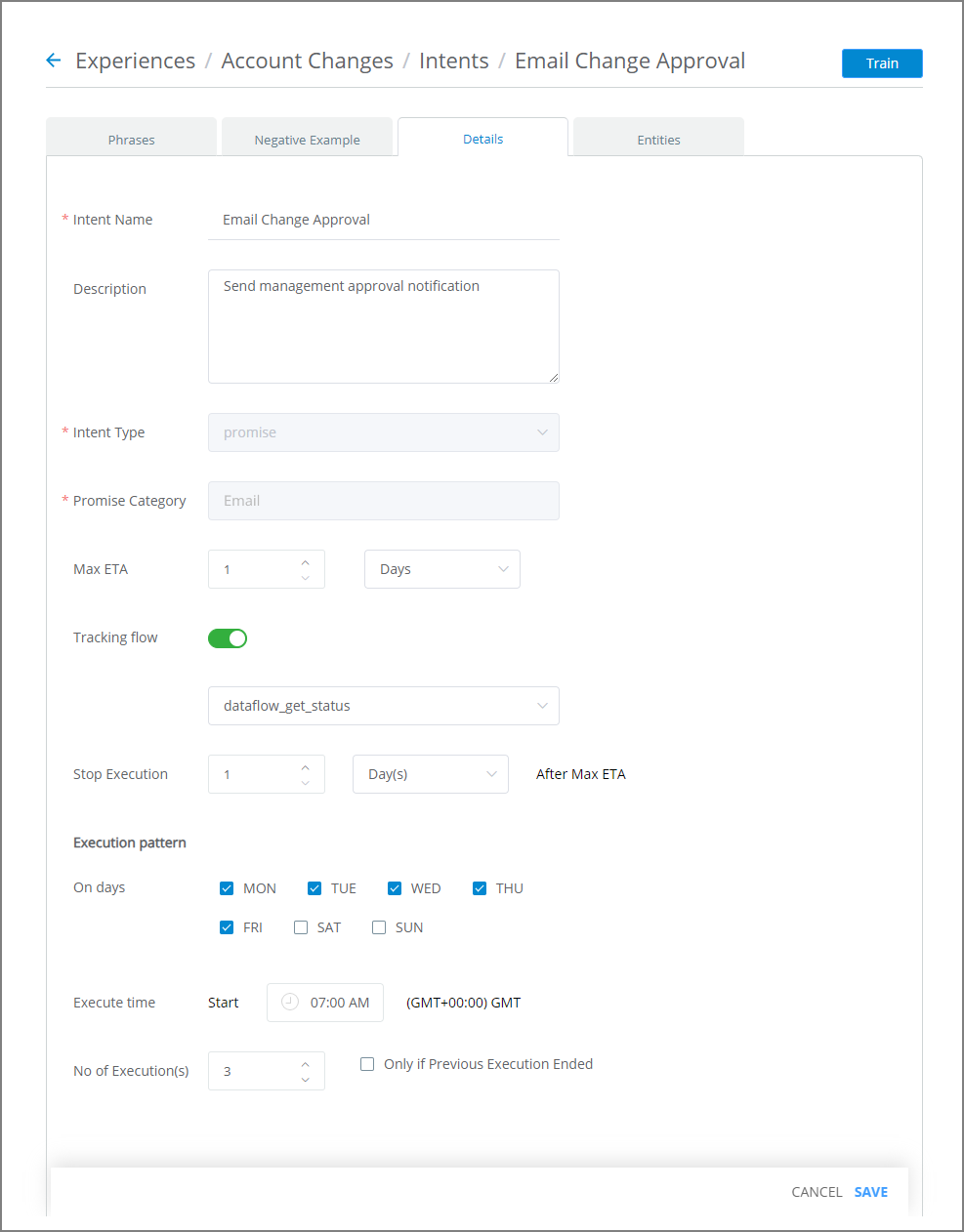Working with Promises
U-Assist supports real-time AI-based Promise management for call centers, helping to increase productivity and improve customer satisfaction.
When Agent Promises are managed effectively, the need for follow-up inquiries to the call center is minimized. Agents and their Supervisors can focus on real-time activities and successful customer fulfillment becomes simpler.
 |
In U-Assist, Promises are maintained as special types of Intents, enabling X-Platform to automatically recognize them as they are made by the Agent during a conversation. The Agent has the ability to update any attributes of a detected Promise as well as change its AI classification, if needed.
To streamline their automated handling, U-Assist Promises are managed according to standard, built-in categories or customized categories defined for the current account.
U-Assist provides end-to-end monitoring of subsequent actions on each tracked Promise using Intent Flows, Service Flows and additional functionality. A real-time dashboard in the Supervisor Application (ACW) can also reveal which fulfillments are behind schedule, enabling a Supervisor to take timely corrective action.
Basic Workflow for Promises
The typical workflow for using Promises is as follows:
Create a Promise Intent, assigning its Category, adding Intent Phrases (when needed), mapping its associated Entities and setting its Tracking parameters.
Train the Experience that contains the new Promise Intent.
Create and assign the X-Designer Flow that will be used to manage the Promise, monitor its activity status and update its tracking information according to the parameters set. When needed, create one or more Integration Points that will exchange data with required third-party applications.
During a call, the AI Agent Application automatically detects the Promise in the conversation.
After a call, the Agent or Supervisor accepts the Promise and tracking is initiated according to its assigned Flow.
Promise activity is monitored in the Supervisor Application (ACW) and its execution status is tracked until it is fulfilled.
Create Promises
A user with Flow Admin Role or higher can define a Promise for U-Assist to identify during a call and track progress on after a call.
Each Promise is defined as a special type of Intent in an Experience and assigned to a built-in or custom Promise Category that enables U-Assist to classify it as well as determine the methods used for tracking its progress and reporting its status.
When an Agent makes a Promise, it typically requires an action to be taken (e.g., a refund, an upgrade, the physical delivery of a product). A Supervisor uses U-Assist Promise tracking to ensure that the promised action is performed within the required time period.
Create a new Intent, as detailed here.
From the Intent Type dropdown list, select Promise. The additional Promise Type dropdown list will be displayed:

From the Promise Category dropdown list, do one of the following:
Select a built-in 'out-of-the-box' Promise category:
Credit
Examples: Refund an overpayment; Reimburse for loss or downgrade of product/service; Deposit promotion-based account credit
Debit
Examples: Process customer payment for outstanding bill; Process purchase or upgrade of product/service
Electronic
Examples: Perform changes to customer contract, product types, terms of service, account information, etc.
Callback
Examples: Recontact customer based on the outcome of another activity; Recontact customer on a specified date and time
Remote Service
Examples: Perform an installation; Provide troubleshooting, upgrading, or scheduled maintenance
Select the (+) Add new Promise category option to create a custom Promise category for the current Experience (see Step 4).
If you are adding a custom Promise category, in the Promise Category field, enter a unique name for the new type you wish to create.
Whenever you add a custom Promise category, you must also add Intent Phrases (and optionally Negative Examples) in each language that will be used by the Experience. For complete details about adding Intent Phrases to an Intent, click here.
At the lower right corner of the popup, click Create. The new Promise Intent will be saved. To cancel your activity at anytime without saving, click Cancel.
After you create a Promise-type Intent, you may also need to add Intent Phrases and (optionally) Negative Examples.
Adding Promise Intent Phrases
Like other Intents, a Promise-type Intent can use Phrases and Negative Examples to train the Uniphore NLU server to identify the Intent during a conversation, as well as enable U-Assist to monitor and track the Promise.
Note
If you assigned one of the built-in Promise categories (i.e., Credit , Electronic, Callback, etc.) for the Promise-type Intent, you are not required to provide additional Phrases for the Intent. These Promise categories are automatically identified by the NLU Server 'out-of-the-box'. However, you may still choose to provide supplemental Intent Phrases to help improve the AI Model for your specific Experience.
Promise Intent Phrases are similar to the phrases supplied for other Intent types, and you also add them on the Intent Training page. For complete details about how to add Phrases for an Intent, click here.
Setting Tracking Parameters for a Promise Intent
U-Assist can track real-time progress of a Promise-type Intent and monitor its status using a X-Designer Flow, when required. You assign the Flow in the Details panel for the Intent, along with the parameters that will be used for tracking.
A Supervisor views progress and status values on the Promise Management page of the U-Assist Supervisor application.
Click the Details tab on the current Promise Intent page. The Details panel is displayed:

Optionally update the Intent Name and Description text fields, if needed.
To enable tracking for the current Promise Intent, enter or update the settings for the following fields:
Promise Category
The Promise category assigned when the Intent was created.
When a built-in category is assigned, this field will be read-only. When a custom category is assigned, it is possible to change the category assigned using this field.
Max ETA
Use the counter widget and dropdown list to set the maximum time to be allowed for the Promise to be fulfilled.
Tracking Flow
To activate Promise tracking, click the toggle switch. When enabled, the toggle color is green and additional tracking settings are displayed.
Select Tracking Flow
From the dropdown list, select the X-Designer Flow that will be executed to perform the Promise tracking.
Only Service Flows and Data Flows will appear in the list of available Flows.
Stop Execution
Use the counter widget and dropdown list to set the period of time that the assigned Flow will be available to execute after the Max ETA value has been reached.
(Execute) On Days
Activate one or more checkboxes for each weekday the assigned Flow will execute.
Execute Time
Enter a value, or use the clock widget, to set the time at which the assigned Flow will start execution.
No. of Executions
Use the counter widget to set the total number of time the assigned Flow will execute.
By default, a gap of 30 minutes is set between executions. For example, if you select 9 AM as the Start time and set 4 occurrences, the Flow will run at 9, 9:30, 10 and 10:30 AM.
Optionally, activate the Only if previous execution ended checkbox to prevent the assigned Flow from running again if a prior execution is still active.
When finished, click Save. The newly entered Promise Intent details and tracking settings will be saved
Once tracking has been configured, whenever a Promise Intent is recognized for an Experience, the assigned X-Designer Flow will execute accordingly to provide any additional actions or functionality that are defined in the Flow.
To see a simple example of a Flow (and components) that can be used for Promise tracking, click here.
Assigning Variables to Entities Used by Promises
Like other Intents, a Promise-type Intent uses assigned Entities to enable monitoring and tracking by U-Assist.
Each Entity is mapped to a specific Session Variable that will be updated during a call by the X-Designer Flow and by external applications when required.
Click the Entities tab on the current Promise Intent page. The Entities panel is displayed:

Note
When a built-in Promise type (i.e., Credit , Callback, Email, etc.) has been chosen for the Promise Intent, some Entities may already be listed and mapped to Session Variables in the panel.
To map add a new Entity to a Session Variable, click Add Variable. A new mapping row will appear in the panel.
In the Variable column, from the Select Variable dropdown list, select the Session Variable or Slot to map. Only the variables available from the current BP will be listed.
In the Label column, in the Type label to be presented... text box, enter the label that will appear with the mapped variable in the Call Summary that is displayed at runtime. The Agent will see this label.
Switch the Show/Hide toggle On or Off to configure visibility of the Entity in the Call Summary that is generated at runtime.
When finished, click Train to store new Entity mappings together with the Experience on the Uniphore NLU server.
To delete an existing mapping, click the Trash  icon at the right side of the relevant row.
icon at the right side of the relevant row.